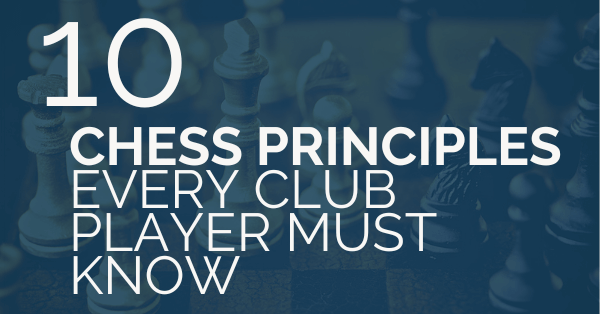Chess is a game of strategy and skill. The opening moves can set the tone for the entire match.
Mastering the basics of chess openings is crucial for any player. Understanding these principles can help you control the board, protect your pieces, and create opportunities. Whether you’re a beginner or looking to refine your skills, knowing these key principles can make a significant difference.
This guide will introduce you to ten essential chess opening principles that every player should know. By following these guidelines, you can improve your game and increase your chances of success. Ready to dive in? Let’s explore these important strategies.

Credit: thechessworld.com
Control The Center
One of the key principles in chess openings is to control the center. This principle serves as the foundation for all other opening strategies. By dominating the central squares, you gain more space, enhance your pieces’ mobility, and restrict your opponent’s movements.
Why The Center Is Crucial
The center of the chessboard consists of the squares e4, e5, d4, and d5. Controlling these squares gives you a strategic advantage. It allows you to move your pieces freely and control key lines of attack.
When you control the center, your pieces can move to any part of the board quickly. This makes your overall position stronger.
Central control also limits your opponent’s options. It restricts their piece movement and forces them into a defensive position.
Examples Of Central Control
Let’s look at some common examples of opening moves that control the center:
| Opening Move | Explanation |
|---|---|
| 1. e4 | This move controls the d5 square and opens lines for the queen and bishop. |
| 1. d4 | This move controls the e5 square and opens lines for the queen and bishop. |
| 1. Nf3 | This move controls the d4 and e5 squares, preparing for further central control. |
| 1. c4 | This move prepares to control the d5 square indirectly and supports future central expansion. |
These opening moves ensure that you have a strong foothold in the center early in the game. Practice these openings to improve your game and outmaneuver your opponent.
Develop Your Pieces
Developing your pieces is a fundamental principle in chess. It means moving your knights, bishops, and rooks into effective positions early. These pieces have more power in the game than pawns. Proper development helps you control the board and create threats. Understanding this principle can make a big difference in your games.
Importance Of Development
Development sets the stage for your strategy. It helps you control key areas. Knights and bishops are stronger in the center. Moving them early lets you dominate the middle of the board. Early development also frees up your rooks. This makes your whole army ready for action.
Efficient Piece Placement
Place your pieces where they can be most effective. A knight on the edge has fewer options. A bishop blocked by pawns is less useful. Aim to place pieces on active squares. This gives you more control and flexibility. Efficient placement also helps you support other pieces. This creates a strong, connected formation.
King Safety
King safety is a crucial aspect of chess strategy. Ensuring your king is secure is essential for a strong position. Proper king safety can prevent early checkmates and give you a better chance at winning.
Early Castling
One of the best ways to ensure king safety is early castling. Castling moves your king to a safer position, away from the center. This also connects your rooks, enabling better coordination.
Choose the right moment to castle. Don’t delay it for too long. Castling early can help you avoid unnecessary threats. It also helps in activating your rook early in the game.
Avoiding Common Pitfalls
Be cautious about moving your pawns too much near the king. Doing so can create weaknesses in your position. It’s important to maintain a solid pawn structure. This ensures that your king remains well-protected.
Watch out for common tactics like the back-rank checkmate. Always leave some room for your king to escape. Avoid neglecting your king’s safety while attacking. A balanced approach is key to a successful game.
Avoid Premature Attacks
In chess, attacking too early can backfire. Many players rush to attack, but this can lead to weak positions. It’s essential to build a strong foundation first. Below, we’ll discuss the risks of early aggression and the benefits of a balanced approach.
Risks Of Early Aggression
Launching an attack without proper setup can expose weaknesses. Your pieces might not be well-coordinated. This can lead to:
- Weak positions
- Loss of material
- Vulnerable king
For instance, pushing pawns too soon can leave gaps. This allows your opponent to counterattack easily. Consider the following table:
| Premature Attack | Possible Consequence |
|---|---|
| Pawn rush | Weak king safety |
| Early queen move | Queen gets trapped |
These examples show the risks. Think before you act. Ensure your pieces support each other. This avoids unnecessary losses.
Balanced Approach
Balance is key in chess. Develop your pieces before attacking. This means:
- Control the center
- Develop minor pieces
- Ensure king safety
For a successful attack, all pieces should be active. For example, knights and bishops should be in play. Only then, consider opening lines for a more effective attack. Let’s break it down:
- Control the center: Use pawns and minor pieces to dominate.
- Develop pieces: Move knights and bishops early.
- King safety: Castle to protect your king.
Following these steps ensures a robust position. This makes your attacks more powerful and less risky.
Maintain Pawn Structure
Maintaining a strong pawn structure is crucial in chess. It shapes the game’s flow and can be the backbone of your strategy. A well-maintained pawn structure provides a solid foundation for your pieces, enabling effective attacks and defenses.
Understanding Pawn Chains
Pawn chains are groups of pawns supporting each other diagonally. They create strong structures that are hard to break. A good pawn chain can protect your pieces and control key squares. Aim to form pawn chains that support your strategy and plans.
Avoiding Weak Pawns
Weak pawns are liabilities in your position. Isolated pawns, doubled pawns, and backward pawns are common weaknesses. These pawns can become targets for your opponent. They can also limit your own piece mobility.
Try to avoid creating weak pawns during the opening phase. This will help maintain a solid and flexible pawn structure throughout the game.

Credit: www.pinterest.com
Control Open Files
Controlling open files is crucial in chess. Open files are vertical lines without pawns blocking them. These files are avenues for your rooks to dominate the board. Understanding how to control open files can give you a significant advantage. Let’s explore how to use this principle effectively.
Using Rooks Effectively
Rooks are the most powerful pieces on open files. Place your rooks on open files to maximize their potential. This positioning allows them to move freely and control crucial squares. Rooks on open files can also support other pieces and create threats.
Double up your rooks on the same file. This strategy increases their power and control. It also makes it harder for your opponent to counter your moves. Always look for opportunities to place your rooks on open files.
Creating Open Files
Sometimes, you need to create open files. Exchange pawns to open up lines. This tactic clears the way for your rooks and other pieces. Be strategic about which pawns to exchange. Aim to open files that will give you the most advantage.
Consider pawn breaks to create open files. Push your pawns to challenge your opponent’s pawn structure. This move can open files and disrupt your opponent’s plans. Creating open files can change the dynamics of the game.
Always be aware of potential open files. Plan your moves to control these key areas. Controlling open files can lead to a stronger position and more winning chances.
Knights Before Bishops
In the game of chess, following opening principles can lead to a stronger position. One key principle is developing your knights before your bishops. This simple guideline can help you build a solid foundation early in the game.
Knight Activity
Knights are best developed early in the game. Place them on active squares. This allows them to control the center. Knights are more effective in the center of the board. They can influence many squares from these positions. Early development of knights also helps in connecting your rooks.
Bishop Placement
Bishops are powerful pieces but need open lines to be effective. Placing your bishops comes after knights. This helps in avoiding early blockages. Bishops should be placed on squares that maximize their range. This means they often go to squares where they can control long diagonals.
Following the principle of knights before bishops ensures a balanced opening. It allows for better control and flexibility in your game. Remember, strong opening moves can set the stage for victory.

Credit: academy.chess7.com
Connect Rooks
In chess, connecting your rooks is crucial for a solid game. It ensures that your pieces work together effectively. This principle enhances your overall strategy and opens up new possibilities on the board.
Importance Of Rook Coordination
Rooks are powerful pieces, especially in the endgame. Their strength lies in their ability to control open files. When your rooks are connected, they can support each other better. This coordination maximizes their potential and offers better control of the board.
Connected rooks also protect each other. If one rook is threatened, the other can come to its aid. This mutual support keeps your position strong. Ensuring your rooks are connected is a key part of maintaining a robust defense.
Methods To Connect Rooks
One effective way to connect rooks is to move your knights and bishops off the back rank. This clears the path for your rooks to join forces. Castling early helps achieve this by placing one rook in a central position.
Another method involves advancing your pawns wisely. Avoid blocking your rooks with unnecessary pawn moves. Keep the lines open so your rooks can move freely and support each other.
Finally, always be mindful of your rook placement. Ensure they are on open or semi-open files. This strategic positioning allows them to work together seamlessly. Connecting your rooks strengthens your overall game plan and prepares you for a successful endgame.
Watch Opponent’s Moves
Chess is not just about your own moves; it’s crucial to watch your opponent’s moves. By paying close attention, you can identify their strategies and counter them effectively. This vigilance helps in avoiding traps and seizing opportunities.
Identifying Threats
Always be alert to what your opponent is planning. Look at their recent moves. Ask yourself, what are they trying to achieve? Are they aiming for your king or setting up a fork?
Checking these threats helps in protecting your pieces. It also ensures you don’t fall into a trap. A simple yet effective strategy is to look at the squares that your opponent’s pieces control. This way, you can foresee potential attacks.
| Common Threats | How to Counter |
|---|---|
| Fork | Move a piece to disrupt the attack |
| Pin | Move the pinned piece or block the attacker |
| Skewer | Move the more valuable piece out of the line |
Capitalizing On Mistakes
Everyone makes mistakes, even in chess. By closely watching your opponent’s moves, you can catch these errors. A common mistake is leaving a piece unprotected. This is your chance to capture it and gain an advantage.
Another mistake is advancing pawns too early. This can create weak spots in their defense. Exploit these gaps to control the center or launch a direct attack.
- Look for unprotected pieces
- Notice weak pawn structures
- Take advantage of misplaced pieces
By capitalizing on these mistakes, you can turn the game in your favor. Always be on the lookout for these opportunities and act quickly.
Plan Your Strategy
In chess, planning your strategy is vital. It sets the foundation for your moves. You need a clear plan to guide you through the game. This section will discuss how to set long-term goals and adapt as the game progresses.
Setting Long-term Goals
Setting long-term goals is key in chess. You must think ahead and plan your moves. This helps you stay focused and avoid pitfalls. Consider these points:
- Control the Center: Aim to control the center of the board. It gives you more mobility and options.
- Develop Your Pieces: Bring your knights and bishops into the game early. This helps you control more squares.
- King Safety: Ensure your king is safe. Castling is a good way to protect your king.
Creating long-term goals helps you stay on track. It also makes it easier to adapt when the game changes.
Adapting To The Game
Adapting to the game is crucial. Your opponent will have their own plans. You must be ready to change your strategy. Consider these tips:
- Observe Your Opponent: Watch your opponent’s moves. Try to understand their strategy.
- Stay Flexible: Be ready to change your plan. If your opponent surprises you, adapt.
- Look for Weaknesses: Find and exploit your opponent’s weaknesses. This can turn the game in your favor.
Being adaptable makes you a stronger player. It helps you navigate unexpected challenges and seize opportunities.
Conclusion
Mastering chess openings can be a game-changer. These principles guide your moves. Remember to control the center. Develop your pieces quickly. Keep your king safe. Avoid moving the same piece twice. Balance offense and defense. Knowing these basics helps you start strong.
Practice them regularly. Improve your game step by step. Enjoy the learning process. Happy playing!
chessmantras.com is a participant in the Amazon Services LLC Associates Program, an affiliate advertising program. As an Amazon Associate, we earn from qualifying purchases made through our links.







